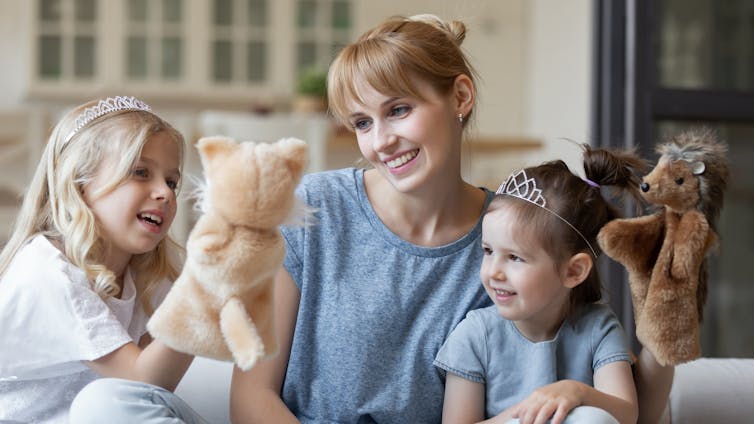Talking through play: 3 ways puppets can help your child open up
- Written by Olivia Karaolis, PhD Student, University of Sydney
Children come into the world ready to communicate. A baby cries and coos to express their feelings and respond to sounds. The ability to communicate develops quickly but uniquely in every child.
By the age of three, most children are able to understand simple requests such as, “pick up your shoes and bring them to me”. They can identify colours, shapes or food groups and use familiar names to recognise important people in their lives, like “grandma”. And they can respond to “who”, “what” or “where” questions.
At three, your child may be saying a lot of words and putting them together into simple sentences. They may ask questions (often a lot of questions) such as, “Where are we going?”
It is an exciting and wonderful time for children to learn about their world and share their discoveries. It can also be a time of anxiety, if a child is not showing the communication signs the parent expects them to at a particular age.
Children learn to speak and develop their communication through day-to-day interactions with their parents and caregivers.
In 2019 as part of my yet unpublished research (that draws on previous work in the United States), I went to three different preschools to work with three to four year olds using puppets. I observed all the children — including kids with a disability, those learning English as an additional language or those who are very shy — communicated more often and more effectively when talking to a puppet.
Research with school-aged children shows puppets, like a favourite doll or teddy bear, can encourage learning and improve communication and behaviour. Talking to a puppet, as opposed to a person, makes the conversation feel less personal and more pretend. It is a play-based technique sometimes used in therapy to help the child feel less self-conscious, and open up.
Read more: Children can't always read between the lines. Sometimes it's better to be explicit
I noticed the joy puppets brought to the children, as well as a growth in their understanding of feelings and the feelings of others. The children showed greater confidence when speaking to puppets and engaged in positive social interactions such as taking turns and sharing.
Parents can also use puppets to support their child’s development at home. Here are three things puppets can help with.
1. Use puppet play to encourage conversation
We introduced a range of puppets to children and quickly discovered the type of puppet used was important. Dinosaurs were very popular as was a duckling named Mabel and a Great White Shark called Bruce.
Think about the animals, characters, colours or creatures your child likes before choosing a puppet to add to your family. You can even make a simple puppet with an old sock.
Once you have your puppet, introduce it thoughtfully to your child. For example, you may pat it softly and have your child touch it with you. Ask your child to help you discover the sounds the puppet makes, its name and what it likes to play.
 Think about the toys and animals your child likes best.
Shutterstock
Think about the toys and animals your child likes best.
Shutterstock
Make your child the expert in bringing your puppet to life. Through the creation of the puppet you can build your child’s vocabulary by modelling descriptive words and longer sentences.
For young children, try narrating their actions with the puppet. For example, “You are patting the puppet’s yellow beak, I think he likes it”.
Play peek-a-boo, sing songs or tell stories. The important thing to remember is to have fun.
2. Use puppets to get your child to answer questions
Try using a puppet to ask questions about your child’s day at preschool, their favourite part of a story or about their drawings or play.
Your puppet can help your little one by offering prompts such as, “Tell me about what you ate at snack time” or “I wonder what you made in the sandbox outside”?
Children may open up more to the puppet because they are funny and create a relaxed and playful environment, which is ideal for interactions.
Other ideas may include using the puppet to make up stories together or to take the puppet on a walk and ask questions about the things you see together.
3. Use a puppet to talk about feelings
Three year olds may find it hard to name their feelings or identify the reason they may be happy or upset. A puppet can act as a soothing way to have children tell you how they feel or learn the names of feelings.
For example, the puppet can use an angry voice or be crying to express emotion. Involve your child in helping the puppet by naming its feelings and coming up with possible solutions to their distress.
Two puppets can act out a frustrating situation and model new approaches such as sharing a favourite toy, trying new foods or cleaning up.
Puppets are a creative way to bring about speech and communication with your child. By bringing fun and imaginative play into your day, you can help your child develop their ability to share their world with you.
Read more: Children learn through play – it shouldn’t stop at preschool
Authors: Olivia Karaolis, PhD Student, University of Sydney
Read more https://theconversation.com/talking-through-play-3-ways-puppets-can-help-your-child-open-up-132353



